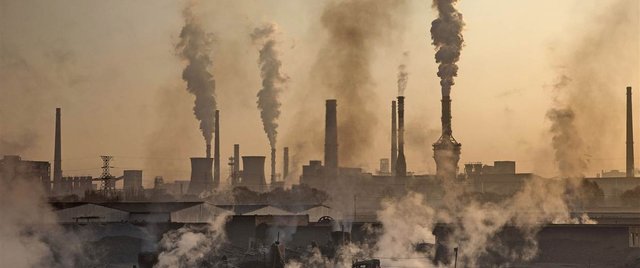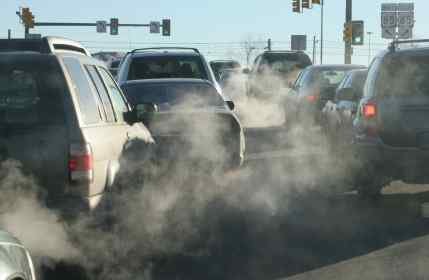The Ecological Crisis & Its Solution (Part 2): More Climate Science for Skeptics
The Carbon Cycle & The Delicate Balance of the Planetary Ecosystem

Modern industrial society runs on fossil fuels: we burn natural gas and propane to heat our homes, burn coal to make electricity, and burn gasoline to run our automobiles. Fossil fuels are composed of organic material—plants and animals—that have decomposed and been put under pressure beneath the earth for millions of years. Crude oil, for instance, is what is left of ancient plankton. Contrary to popular belief, fossil fuels aren't liquefied dinosaur remains. We are literally burning ancient algae and swamp muck from dead bacteria. What we are burning is what remains of ancient carbon-based lifeforms. When we burn fossil fuels, we are taking carbon that has been buried beneath the earth in solid or liquid form for hundreds-of-millions of years and causing it to combust and be released into the atmosphere.

The Earth has a natural carbon cycle. Plants consume H2O (water) and CO2 (carbon dioxide) and convert them into carbohydrates (sugars) and oxygen through photosynthesis. Technically, during photosynthesis all of the oxygen atoms from CO2 go into carbohydrates, while the oxygen atoms released into the air by the process actually come from the breaking apart of H2O. So plants don't technically convert carbon dioxide into oxygen, but they do remove carbon dioxide from the air and replace it with oxygen. Animals consume carbohydrates and oxygen in order to survive. When we breath in oxygen, we breath out carbon dioxide. The carbon is cycling though the planetary ecosystem, switching forms as it goes. Ultimately, we find a delicate balance.
By taking carbon that has been trapped beneath the earth for 300 million years and releasing it into the atmosphere through combustion, we are throwing off the delicate balance. The carbon atoms contained in fossil fuels have not been part of the carbon cycle since at least 297.5 million years before humans arrived on this planet. By taking this carbon from beneath the earth and releasing it into the atmosphere through combustion, we are placing carbon into the carbon cycle that has not been part of the carbon cycle since long before the first mammals emerged upon the face of the Earth.
This may not seem like much of a problem, but allow me to point to a somewhat analogous problem. Imagine a farmer raises livestock. His livestock produces waste in the form of fecal matter, which he can use as manure to fertilize his crops. There is no problem with an increase in the amount of waste from animals, so long as the farmer can grow more crops in order to use up the extra manure. However, if the animal waste starts to exceed what can be effectively used as manure, it will start to poison the crops. Here is an article about how too much compost can poison you garden. Here is another article about how too much manure can damage crops. Over-application of manure to farmlands results in nitrates seeping into groundwater, creeks, and rivers. These nitrates can cause health problems in humans and can even cause miscarriages. Just the right amount of manure leads to greater crop yields, whereas too much manure can cause an ecological disaster. Likewise, the right amount of carbon dioxide is beneficial, but too much carbon dioxide can cause an environmental crisis.
The Problem of Global Warming & How We Know That Humans Caused It
Greenhouse gases trap heat on Earth. The experiment I talked about in Part 1 of this series—the one involving a jar of CO2 and a heat lamp—demonstrates how greenhouse gases work. The jar represents the Earth, the lamp represents the Sun, and the CO2 simply is a greenhouse gas. Greenhouse gases capture and emit heat. Just as our greenhouse gas captured energy from our lamp and retained it in the jar in the form of heat, so also do greenhouse gases in the atmosphere capture energy from the sun, retain it, and emit it as heat. This process is what is behind global warming. CO2 is not the only greenhouse gas. There are other greenhouse gases too, like methane (CH4), SO2 (sulfur dioxide), CFCs (chlorofluorocarbons), and water vapor. Increases in the amount of many greenhouse gases in the atmosphere result from human activity. SO2 and NOX, for instance, are released into the atmosphere when we burn coal. You might be aware that CFCs were once contained in hairspray bottles and other aerosol cans and contributed to the creation of the hole in the ozone layer.
Scientists have established that the amounts of various greenhouse gases in the atmosphere are rising and that the Earth is heating up as a result. Climate science skeptics often ask, "Well, how do we know that the increase in greenhouse gases is the result of human activity?" Well, there are several ways to determine this. The simple answer is basic logic. If we analyze the chemical composition of emissions released from the combustion of fossil fuels, we can see that CO2 and SO2 are among the chemicals released. We know that the carbon in fossil fuels was trapped deep beneath the earth for millions of years, so the releasing of this carbon into the atmosphere logically has to mean that we are increasing the amount of carbon in the carbon cycle. We can deduce that combustion of fossil fuels must logically lead to an increase in CO2 in the atmosphere since we are adding additional CO2 on top of the CO2 that is already naturally produced by the carbon cycle. The more complex and scientific way that we can tell that increased levels of greenhouse gases are caused by humans is by analyzing isotopes. Each element can come in various isotopes. The isotope refers to the number of neutrons within the atom. Every carbon atom has 6 protons. However, the number of neutrons may vary. Thus, carbon12 has 6 protons and 6 neutrons, while carbon13 has 6 protons and 7 neutrons, and carbon14 has 6 protons and 8 neutrons. Plants contain more lower carbon isotopes like carbon12 than higher carbon isotopes. This is how one article explains how analyzing isotopes reveals the source of CO2 emissions:
"Another, quite independent way that we know that fossil fuel burning and land clearing specifically are responsible for the increase in CO2 in the last 150 years is through the measurement of carbon isotopes. Isotopes are simply different atoms with the same chemical behavior (isotope means “same type”) but with different masses. Carbon is composed of three different isotopes, 14C, 13C and 12C. 12C is the most common. 13C is about 1% of the total. 14C accounts for only about 1 in 1 trillion carbon atoms.
"CO2 produced from burning fossil fuels or burning forests has quite a different isotopic composition from CO2 in the atmosphere. This is because plants have a preference for the lighter isotopes (12C vs. 13C); thus they have lower 13C/12C ratios. Since fossil fuels are ultimately derived from ancient plants, plants and fossil fuels all have roughly the same 13C/12C ratio – about 2% lower than that of the atmosphere. As CO2 from these materials is released into, and mixes with, the atmosphere, the average 13C/12C ratio of the atmosphere decreases."(How do we know that recent CO2 increases are due to human activities?)
I know that I have already said this, but it is worth repeating for emphasis: Since we know that we are releasing CO2, SO2, and other greenhouses gases from fossil fuels into the atmosphere through combustion—and we know that the elements in these chemicals were previously trapped beneath the Earth's surface for hundreds-of-millions of years―, it would be absurd to think that we were not causing an increase in greenhouse gases. While the normal natural processes on our planet continue to break down and produce greenhouse gases at the same rate as usual, we are pumping tons of additional greenhouse gases into the atmosphere from a different source, a source deep beneath the surface of the Earth. It is as if we have cracked open Pandora's box and released all the evils upon the Earth. We have cracked open the ground, removed the fossil fuels, and released pollution upon the world.
Very interesting article, but do not forget to cite your sources and credit your images.
Wonderful post
por mas que no queramos siempre vamos a contaminar ya que el ser humano es el ser mas destructivo sobre la tierra!muchas gracias por tu publicacion felicidades
This is a very big problem nowadays which really bothers me too. I think my last article about Chinese pollution might be interesting for you.
This is part 02 of climate science. You've nicely introduce Carbon cycle and delicate balance of the planetary ecosystem. Glad to accept my salute. Best introduce video discussion. All of better.
I think your blogs gave to best message to humanity.
thanks for info we have not to pollute our earth @ekklesiagora
wow!amazing post..i like your every post..i appreciate your blog..thanks for sharing this post..best of luck...resteemit..